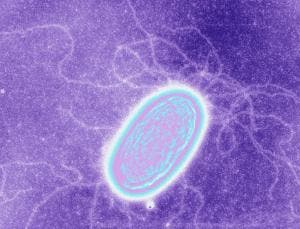
Most living beings on this planet need to go through at least several stages before they can extract the pure energy found in food. More and more convincing evidence suggests, however, that there are numerous bacterial species that consume electricity, thus feeding on energy directly. No oxygen, no ATP, nada. There are many things we can learn from these newly found energy sipping creatures; for one, the electric bacteria might tells us what are the minimal energy requirements for life or, as a long shot, how life itself can be generated.
Scientists have known for some time about two such types of bacteria that eat electrons harvested from rocks, called Shewanella and Geobacter. Kenneth Nealson at the University of Southern California, Los Angeles and his colleagues have found however that there are many more such bacteria that can be enticed to surface, many of whom are different species with different behaviours.
The electron must flow…
The team collected sediments from the seabed, brought them to the lab, then inserted some electrodes in them. Beforehand, the natural voltage of the sediment is measured. A slightly higher voltage offers an excess of electrons; a slightly lower voltage means the electrode will readily accept electrons from anything willing to pass them off. For the bacteria, a higher voltage means they can ‘eat’, while a lower voltage allows them to ‘breath’. Each bacteria has a different current as demonstrated by the signal the researchers picked up.
“Basically, the idea is to take sediment, stick electrodes inside and then ask ‘OK, who likes this?’,” says Nealson for New Scientist.
How surprising is this? Not that much, according to Nealson, considering if you boil down life to its very fundamentals it can be summed up as a flow of electrons.
“You eat sugars that have excess electrons, and you breathe in oxygen that willingly takes them.”
Typically, beings such as ourselves break down sugars using enzymes to make ATP, a molecule that acts like an energy storage unit for most living creatures. In the end, it’s all about moving electrons to reach the oxygen.
“Life’s very clever,” says Nealson. “It figures out how to suck electrons out of everything we eat and keep them under control.” In most living things, the body packages the electrons up into molecules that can safely carry them through the cells until they are dumped on to oxygen.
“That’s the way we make all our energy and it’s the same for every organism on this planet,” says Nealson. “Electrons must flow in order for energy to be gained. This is why when someone suffocates another person they are dead within minutes. You have stopped the supply of oxygen, so the electrons can no longer flow.”
It doesn’t necessarily have to be like this, however. The bacteria Nealson and his team have discovered prove there doesn’t have to be a sugary middleman and that there can exist life that feeds on pure energy alone, at least at a rudimentary level. So far, Nealson along with his doctoral student Annette Rowe have identified up to eight different kinds of bacteria that consume electricity.
“It is truly foreign, you know,” says Nealson. “In a sense, alien.”
Now, the researchers are growing some of these bacteria in the lab directly on electrodes, feeding them nothing but electricity. Imagine plugging a DC cord in mouth at noon for 15 minutes instead of eating. Yuuum, batteries full!
Finding so many different energy eating bacteria tells us that there’s a whole new microbial world waiting to be explored, which is why some teams will install a battery inside a gold mine in South Dakota to see what they can find living down there. NASA is also interesting in what they can find, since any beings that live on low amounts of energy might hint how alien life might be able to survive in extraterrestrial worlds. Far more important, however, electric bacteria might help unravel the secrets of life.
“An electric bacterium grown between two electrodes could maintain itself virtually forever,” says Yuri Gorby, a microbiologist at the Rensselaer Polytechnic Institute in Troy, New York: . “If nothing is going to eat it or destroy it then, theoretically, we should be able to maintain that organism indefinitely.”






